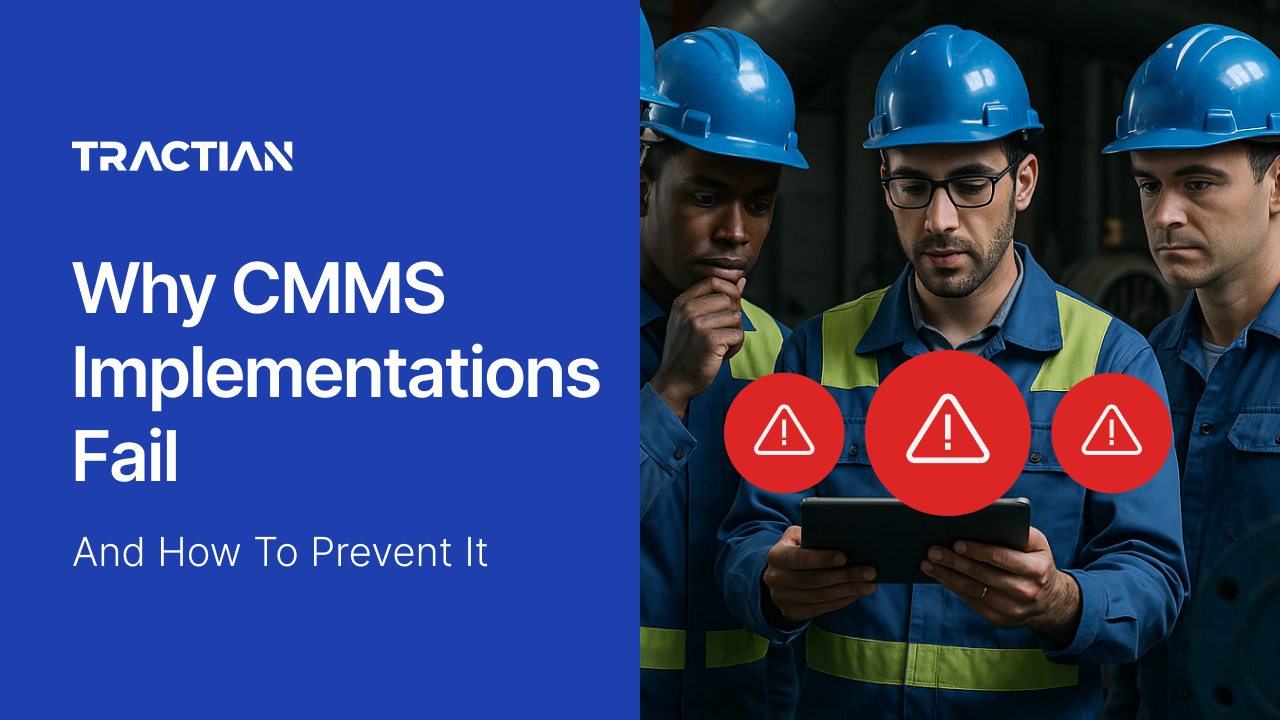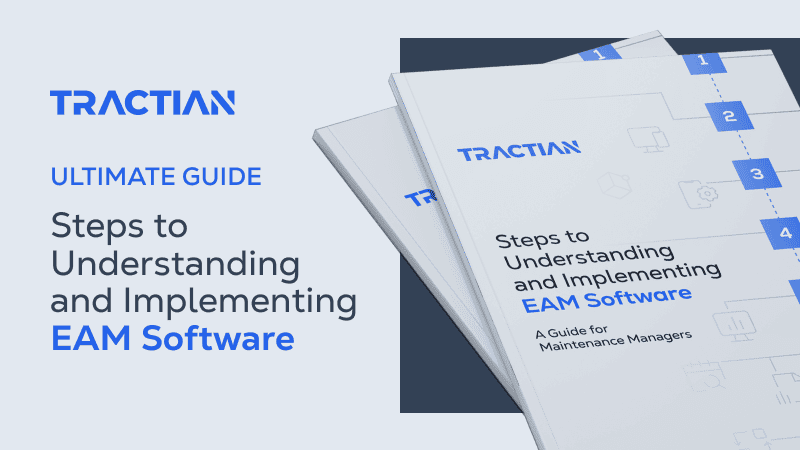Most CMMS projects don’t fall short because of technology. The real reason CMMS projects fail is because they lack a solid groundwork to support them..
It’s a familiar story. A plant adopts a CMMS hoping to bring structure to its maintenance operations and cut downtime.
But months later, the system isn’t delivering. Adoption is low, schedules are off track, and work orders are still being passed around without any real resolution.
The problem is that expectations rarely line up with execution. A CMMS won’t automatically fix broken workflows or compensate for poor planning.
That’s why nearly 80% of CMMS implementations don’t reach their full potential. Not because the teams didn’t try hard enough, but because their implementation strategy wasn’t designed for long-term success.
In this article, we’ll explain why CMMS implementations fail, along with how to avoid common pitfalls. Armed with these tips, you can build a CMMS rollout that actually aligns with your operational goals.
What Does a CMMS Software Do?
A CMMS (Computerized Maintenance Management System) is designed to centralize and streamline every aspect of maintenance operations. It brings structure and clarity to what often lives scattered across dozens of spreadsheets.
This structure and clarity provide better control over work orders, preventive maintenance, and more, keeping everything stored and tracked in one place.
But the real value of a CMMS doesn’t just lie in digitizing paperwork, it actually transforms how maintenance teams operate. A well-integrated CMMS solution builds predictability into your day-to-day, letting you shift from reactive firefighting to structured, planned execution.
It also improves traceability, so maintenance tasks can be aligned with broader organizational goals.
With a CMMS, every link in the maintenance chain gains a strategic advantage.
Why Set Up a CMMS Software?
Without a CMMS, maintenance decisions are inconsistent and and often based on incomplete information. A CMMS is the operational backbone that connects people, assets, and data in real time.
For teams managing dozens or hundreds of assets, trying to track everything manually across disconnected systems is inefficient and risky. Missed work orders turn into breakdowns. Incomplete histories lead to repeat failures.
In scenarios like these, preventive maintenance becomes reactive by default.
Implementing a CMMS creates structure where there isn’t any. It enables standardized processes and clear accountability. Instead of maintenance controlling teams, teams control maintenance.
If a CMMS software can do all that, why is it so tricky for businesses to implement then?
Why Do CMMS Implementations Fail?
Adopting a CMMS should be a strategic turning point for a facility, but all too often it turns into a stalled project with little impact. When that happens, it’s not because the CMMS itself failed.
It’s because the actual execution missed what makes implementation work.In that vein, here’s what to avoid when implementing a CMMS:
1. Not Being Willing to Put in the Time to Get it Going
You can’t just plug-and-play with a CMMS. It’s a system that depends entirely on how well it's structured, how clean the data is, and how consistently people use it. Skipping or rushing through that groundworkguarantees long-term problems.
This early phase is where key decisions are made: For example, how asset hierarchies are built, what work order categories are defined, and how users are grouped. This foundation sets the tone for usability and reliability down the line.
But when teams don’t carve out the time to get it right, they end up with a system that reflects the same disorganization they were trying to escape.
And this isn’t just about filling in data fields. It’s about building a CMMS around how your maintenance actually works.
2. Lack of Planning
Lack of planning may be a technical oversight, but it’s also an organizational risk. Too many teams start implementing CMMS software without clear objectives or without considering how the system will scale over time.
Successful CMMS implementation planning starts with asking the right questions:
- What are the specific outcomes we expect?
- What’s our timeline?
- How will we measure success six months from now?
Without those answers upfront, implementation turns into a checklist activity. The system might technically “go live,” but it never becomes the operational core it’s supposed to be.
3. Management Isn’t on Board
When leadership views a CMMS rollout as a tech project rather than an operational transformation, it loses traction before it even starts.
The reality is that CMMS impacts every part of maintenance, and if leadership isn’t actively driving adoption, teams will see it . as just another system to check into.
It’s not enough to approve the budget. Management needs to treat the rollout as a business-critical initiative, with clear communication, ongoing support, and visibility into how the system will elevate performance across the board.
4. Your Team Hasn’t Bought In
If your team isn’t involved from the start, they won’t use the system consistently. And without consistent usage, the platform can’t deliver the value it promises.
Technicians, planners, and supervisors are the core users of a CMMS, but too often they’re brought in late(or not at all). When the system doesn’t reflect their day-to-day reality, they stop using it.
Or worse, they use it inconsistently, undermining the data and reducing trust in the platform.
Adoption isn’t just about training, it’s about building ownership. That means involving the team early in the process, and especially during feedback loops.
At the end of the day, buy-in isn’t about compliance. It’s about building a system people want to use because it makes their work easier.
5 Benefits of a CMMS
When implementation falls short, it's easy to blame the system. But the truth is: when done right, a CMMS is one of the most valuable tools in your entire operation.
It’s not just about tracking maintenance tasks, but building a smarter, more resilient maintenance process. Take a look at a few benefits that a CMMS brings to your operation:
Reduced Downtime
With clear preventive schedules and faster failure response times, teams can catch problems before they escalate. This means fewer unplanned stops, better asset availability, and more predictable production cycles.
Time and Resource Efficiency
No more chasing work orders. Everything a technician needs is right where it should be. That kind of organization helps maintenance teams close more jobs with less overhead.
Improved Planning and Execution
A CMMS brings structure to every level of planning, allowing maintenance leaders to prioritize tasks, and deploy resources where they’ll have the biggest impact, enabling more strategic execution.
Data-Driven Decisions
A modern CMMS gives you access to useful, usable history. For example, teams can track failure trends and calculate cost impacts with more confidence, turning maintenance from a cost center into a performance driver.
Alignment with Organizational Goals
Whether it’s compliance or sustainability, a CMMS gives leadership the visibility to connect maintenance execution with broader business outcomes.
Why Your CMMS May Not Be Meeting Expectations
Even when a CMMS is technically operational, it can still fall short. It’s not because the platform is broken, but because the problems it was meant to solve were misunderstood or mishandled.
Here are a few of the biggest mistakes businesses make when integrating a CMMS:
Solving the Wrong Problem with a CMMS
A common misstep is trying to use CMMS software as a fix-all. But if your plant is built on an unstable foundation, then the system won’t fix that,it’ll just expose it.
A CMMS works best when it’s introduced to enhance an already mature process, not to compensate for a missing one.
If your maintenance operation is still reactive and there’s no plan to move toward preventive or condition-based approaches, a CMMS alone won’t change that trajectory.
Lack of Organizational Goals
Without defined, high-level goals tied to maintenance outcomes, a CMMS becomes just another system.
What often gets missed is direction. Is the goal to reduce downtime by a specific percentage? Improve audit readiness?
If those objectives aren’t set before implementation, teams default to just checking boxes and never build toward something bigger.
Insufficient Change Management
Even the best platform fails without the right support structure. CMMS implementation fundamentally changes how people work. That shift requires more than training.
It requires leadership and commitment across every level.
That’s why Tractian works side-by-side with maintenance teams during rollout, offering hands-on onboarding, targeted training sessions, and ongoing support to ensure the system adapts to your unique operational needs.
How to Prepare for a Successful CMMS Implementation
The success of your CMMS begins long before launch. You need a strong implementation to set the stage so that when the system goes live, it's actually aligned with how your team works.
Here’s where to start:
Get Your Data in Shape
Before anything else, clean up the data you already have. Duplicates, outdated entries, and vague task descriptions will only create confusion once everything’s inside the system.
It’s not glamorous work, but it’s what makes the rest of the rollout possible.
Know What You're Solving
Not every team adopts a CMMS for the same reason. The point is: Know what your pain points are, and define what success looks like. That’s what should guide the way the system is configured and used-not just a checklist of features.
Put Names to Responsibilities
There’s a roll for everyone during rollout. The earlier everyone’s jobs are clear, the smoother everything runs.
Plus, this builds accountability into the process from day one.
Bring in Your Techs Early
A CMMS isn’t just for supervisors and planners, it's for everyone actually doing the work. If they don’t see their workflow reflected in the system, they won’t use it.
So, let your techs weigh in on how tasks are structured, how information gets entered, and what helps (or slows them down) in the field.
Roll it Out in Phases
Trying to launch everything at once almost always backfires. Start with the basics, then work your way up toward more mission-critical tasks
Each phase gives you a chance to test and adjust without overwhelming the team.

How To Choose The Best CMMS Software
The right CMMS isn’t the one with the most features, it’s the one that matches how your operation actually works. It should be easy to use, quick to adopt, and powerful enough to support your team in the long-term.
But software alone isn’t enough. You need a partner who stays involved beyond day one implementation. That’s where Tractian stands apart.
Our CMMS is built for industrial teams that need results. And we don’t just help you with implementation-we’re there for you anytime you need us.
With real-time tracking, automated scheduling, mobile-first design, and hands-on onboarding, our solution helps your industry go from reactive to truly proactive maintenance,without the learning curve.
If you're ready to implement the software successfully, take a look at how Tractian's CMMS can make your operation easier and more profitable.



